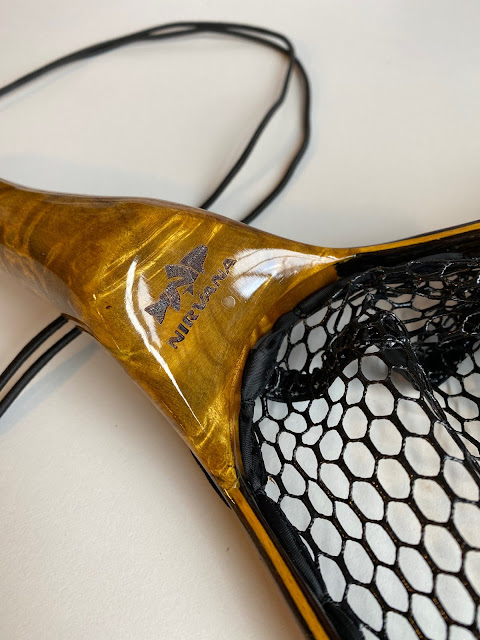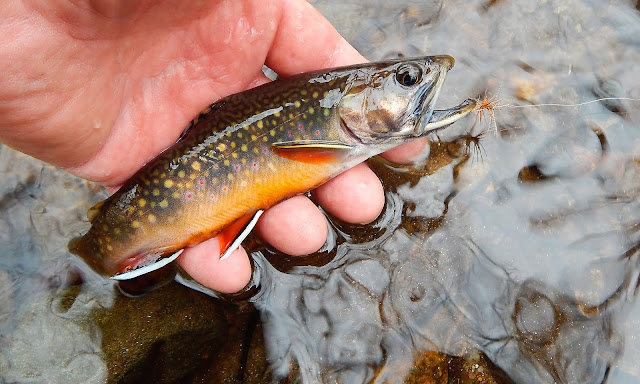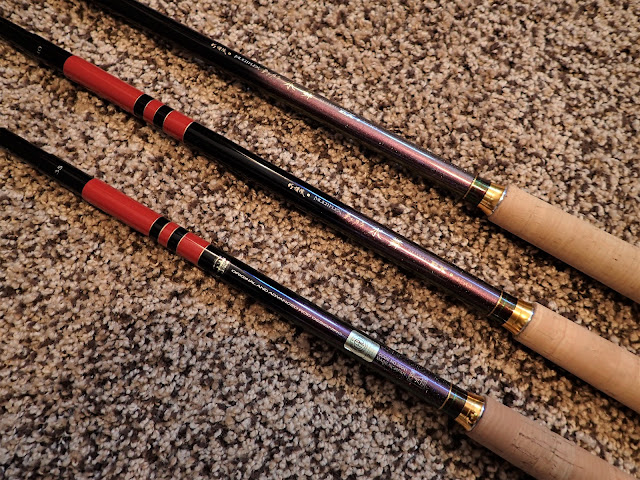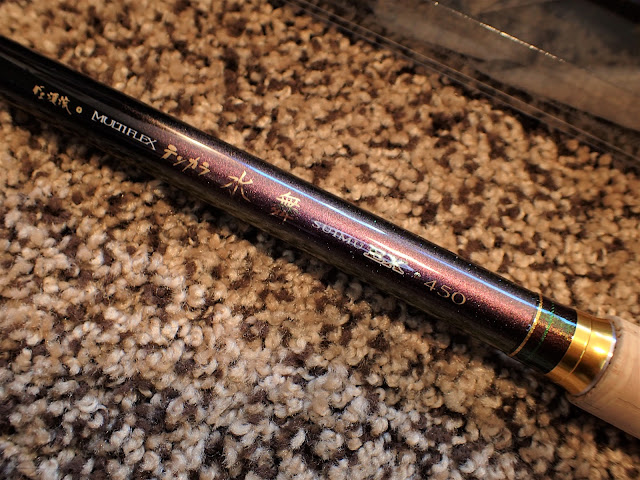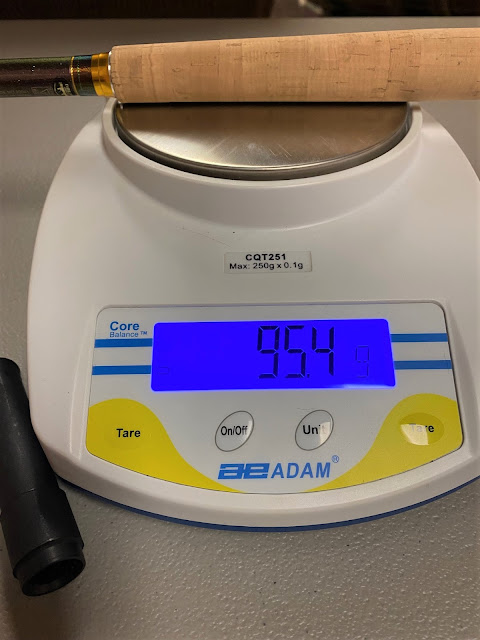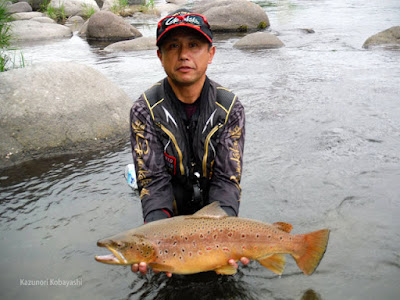February 27, 2022
February 24, 2022
Rotational Moment of Tenkara Rods 4 meters and Longer
When it comes to fishing big water for big trout, tenkara has traditionally been the odd man out. We've all heard the argument, "tenkara was never meant for large fish. In Japan, a large ______ (insert Iwana, Yamame, Amago) is 40 cm (15.8 inches)". Pursuing these "large" salmonids is the realm of the Shaku hunter. In order to successfully be considered a Shaku Hunter, one must catch one of these fish that measures over 30.3 cm, a task that to some may never be accomplished. (Ref. 1)
But soon after tenkara arrived in America, folks started trying to catch the largest trout that they could using tenkara rods and gear. Rods were breaking right and left, and tenkara was getting laughed at by traditional fly fishers as a tool meant for children chasing small trout.
Then along came some pioneers. You know them, Brent Auger, Karin Miller, Rob Worthing, Eric Ostrander, and others. These tenkara anglers refused to stick with small trout; they went for much larger fish than tenkara was intended. But early on, the tools to tackle large trout didn't readily exist. Tenkara USA came out with the Amago, and Chris Stewart imported the Daiwa Enshou LT44S-F and some keiryu rods (most of which had light tippet ratings), but these few 4+ meter rods didn't always answer the needs of these "American Shaku Hunters".
Nowadays, the tenkara angler who wants to fish large water for large trout has many choices. What a world we live in! But many people have questions regarding these long sticks, such as can they be cast one handed and how heavy do they feel? Well, even though I'm not a Shaku hunter, and prefer catching trout smaller than 16 inches, I thought I'd put together some data for the tenkara community regarding the rotational moment (or torque) of these large tenkara rods.
Just as a reminder, rotational moment is a mathematical tool used to estimate the tip heaviness of a rod. This measurement has been validated and used by Gamakatsu, a premium quality Japanese rod maker. I've written about Moment of Inertia and Swing Weight in the past, but these are harder to calculate, and since Gamakatsu has already accepted rotational moment as a measurement for their rods, I decided just to stick with it.
The rotational moment of a rod is calculated by measuring its weight in kilograms and multiplying that by its center of gravity distance in centimeters from the butt of the rod, when the rod is fully extended. Any number over 6 and the rod begins to feel tip heavy, over 7 and you'll definitely notice. Simply put, the larger the number, the more tip heavy the rod will feel. Likewise, the larger the number, the more stress on your forearm and more chance of micro-tears being induced in the extensor tendons with repeated use (think tennis elbow, ouch!). Moment of inertia is likely a better mathematical model, but it's also more complicated, so rotational moment (RM) makes sense to be the mathematical tool of choice.
I put together a spreadsheet of the currently available tenkara rods advertised to be four meters (13' 1.5") or longer that I've used (or know of) and some of their measurements, including their RM. I might have missed one or two rods, but I think I got most of them (I'm sure I'll hear about any I missed). Now before you say, "what about the Suntech _____, or the Daiwa ______, or the Keiryu Rod Co. ______, let me remind you that this chart is about 4+ meter tenkara rods, not keiryu or seiryu rods. I did include one keiryu rod, the Diawa Kiyose 43M-F, because it's commonly thought of as a "big fish" rod and so many people have one. Besides, it's my chart, and I wanted to include it. I also chose to include the Nissin Zerosum Oni Honryu 395, although it's advertised as a 395 cm rod. It measures nearly 4 meters in length, and so it bears inclusion. Of the rods in the chart with missing data, if you have one of them and would like to contribute data, please contact me (use the contact me form at the top right of this page)!
So, here's the data. I pass no judgment or opinion on any of these rods; I only present the data. I include the Oni Type-I and Tanuki XL-1 for reference, but they are not considered "big fish" rods. BTW, I placed a new tab called Rotational Moment Chart on the Tab Bar of the Teton Tenkara homepage and will update the chart as needed.
For the updated chart, click HERE to ask for the link. Here are some screenshots of the current chart (RFI is the Rod Flex Index):
Conclusion: So, what to do with this data? I don't know. I'll let you decide if it helps you when you're researching 4 meter and longer tenkara rods for larger fish. Maybe you'll find it helpful, maybe not. But at least the data's now out there for the tenkara community to peruse. Use it (or ignore it) as you will! And remember, not all 4+ meter rods are designed to be equal. An Oni Type-II may have the lowest rotational moment, but it won't take down a salmon like the Zen Taka will! So, it goes without saying, when targeting large fish, don't bring a knife to a gun fight! (Ref. 2)
Acknowledgments: I'd like to thank a few people for their help in getting data for rods I didn't have on hand. In alphabetical order: Amanda Hoffner = TUSA Ito, August Gresens = TUSA Ito, Chris Cameron = Anglo & Co. Wasabi 40, David Noll = Shimano BG Tenkara 48NV, John Vetterli = Oni Type-II, Karin Miller = Zen Tenkara Taka, Kris Franqui = Daiwa Expert LT H44, Nick Feller = TRC Rocky, Paul Vertrees = Zen Tenkara Sagi, Tom Bayly = TAO Wisco 2 (he actually sent me one to measure. Thanks, Tom!). I'd also like to thank Karin Miller who reminded me that just because you have a long and powerful tenkara rod, you still have to use correct technique to properly play and land large fish. It takes finely honed skills, not just a rod with some numbers.
Disclaimer: All rods and production runs have slight variations in weight and length. These data may vary slightly from rods from different production runs.
February 22, 2022
NIRVANA Wooden Small Stream Net
NIRVANA ON THE FLY, a subsidiary company of DRAGONtail Tenkara, has released a new small stream net that is both beautiful and functional. Coming in at 7.6 oz. (215.5 g), this net is very lightweight and won't cramp your style when hiking into your favorite blueline creek.
Here are some of the features, as described by NIRVANA:
- Beautiful High Quality Burl Wood
- The Wood Rim is a Darker Burl Wood for a Stylish Look
- Rubber Coated Light Weight Polyester Netting
- Wide & Rounded Handle for Optimal Comfort
- Curved Down Handle Head for Easy Scooping of Fish
- Swiveling Lanyard Connection to Reduce Lanyard Twisting
- Lanyard (elastic) Included
I was able to borrow one of these nets and take it for a spin. I really like the offset handle. It is large enough to fill the palm of my hand and the offset helps keep the netting off my back when I carry the net handle stuffed into my belt.
The wood and finish are really beautiful. The netting is rubber coated polyester mesh, so it's lightweight (unlike clear ghost nets) and fish safe. It worked perfectly on stream with fish up to 14 inches (I didn't catch any larger than this, so I couldn't test the net on them).
All in all, I think this is a fantastic net. I only wish it was around back when I needed a net!
Disclaimer: I borrowed the net from DRAGONtail Tenkara and returned it after the review. I have no formal affiliation with DRAGONtail Tenkara or NIRVANA ON THE FLY, and there was no expectation of a positive review.
February 20, 2022
Rest In Peace, Dear Friend.
It is with sadness that I announce that Alan Petrucci (aka, Brk Trt), author of the blog Small Stream Reflections has died. Alan was a master at both fly fishing and blogging. He was the most prolific of bloggers, and always shared his love of brook trout streams with joy and happiness.
Alan was a friend, although I never met him in person. It is one of the blessings of the internet, that we can make and keep friends that live so far away. I always looked forward to Alan's posts of beautiful Connecticut creeks, the brook trout he caught, and the delicious snacks that he had.
February 17, 2022
Nissin is Releasing a New Tenkara Rod
Usaki Nissin has announced that they will be releasing a new tenkara rod. Named the Professional Keikyo Tenkara, it is designed to be both very light and strong. There are two flex profiles, 6: 4 and 7: 3, with a total of 6 items in the lineup of 320/360/390 cm. Details are yet to be released.
February 15, 2022
Flies and Kebari Collection, Volume 2
First off, I'd like thank all of you who purchased Volume 1 of Teton Tenkara Flies and Kebari Collection. Because of you, I was able to purchase tenkara items to test and review for you. Thank you!
Volume 2 of Flies and Kebari Collection is now ready for purchase! It contains 21 flies and kebari that I frequently use and have featured on my YouTube video journal. Included are various jun, futsu and sakasa kebari, terrestrials, dry flies, and a few bead head nymphs. If you've watched my vlogs then you've seen these flies catch fish.
Volume 2, like Volume 1, is only $12 USD. Volume 2 will come to you as a PDF file, so that you can download it onto your electronic devise for offline viewing. And again, all proceeds from the sale of Volume 2 will go towards supporting the Teton Tenkara blog, and for purchasing further tenkara related items for testing and reviews.
You can buy both Volume 1 and Volume 2 of Teton Tenkara Flies and Kebari Collection HERE. And thank you for your friendship and support!
February 13, 2022
Gamakatsu Suimu 4.5 on Water - Review (Part II)
In part I of my review of the Gamakatsu Suimu 4.5 I discussed it's physical characteristics and attributes. Here, in part II, I'll briefly discuss its use on the water.
I fished the Suimu 4.5 on a typical western tailwater, using a two fly rig consisting of a dropper and point fly. Both of the flies had 3.3 mm tungsten beads, and thus were moderately heavy. My line was 380 cm #3 fluorocarbon level line with 90 cm of 4.5X tippet added.
The Suimu 4.5 cast this fly rig without any complaint. In fact, it handled the flies so well that I could had used even heavier flies had the situation required. With these two flies, I cast the rod using a slow, open loop, but I'm confident that if I was using a single unweighted kebari that a tight loop with high line speed could have been easily achieved. I did decide that for me, I preferred casting the rod at its 4.0 meter length, as at the 4.5 meter length my arm would fatigue. Still, casting at the 4.5 meter length was very doable, and I spend quite a bit of time casting at that rod length. I found that gripping the rod at the upper part of the handle (as opposed to near the butt) worked best for me in both casting and drifting.
I hooked rainbow trout from 10-14 inches and these fish didn't even come close to testing this big, beefy rod. Controlling a 20 inch trout in streamflow conditions would have been easy with the Suimu 4.5, given its power flex action and its long length.
Conclusion: I really like this rod! With its three very useful lengths, the Suimu 4.5 will likely be the rod in the Gamakatsu lineup that I will use most often. All three rods, 4.0, 4.5 and 5.0 meter, have their own distinct personalities and purposes, but I think the 4.5 meter will be in my hand the most when I reach for one of these stellar rods. I guess time will tell.
If you're in the market for a large fish Japanese tenkara rod, a rod that can transition from mountain stream (keiryu tenkara) to mainstream (honryu tenkara), then take a look at the Gamakatsu MultiFlex Suimu 4.5. It's the middle rod in a titan lineup of tenkara rods and will not let you down!
Disclaimer: My opinion regarding this rod is just that, my opinion. Your opinion may differ. Also, your rod may not have the same length, issues, or functionality as my rod. There are variations between rods, even in the same production run. No description can fully tell you how a rod feels or fishes. For this, you must personally hold, cast, and fish the rod then make up your own mind.
I have no affiliation with Gamakatsu, and I purchased the Suimu 4.5 at full retail price.
February 6, 2022
February 2, 2022
Gamakatsu MultiFlex Suimu 4.5 EX Tenkara Rod - middle rod in a TITAN lineup of rods! (Part I)
I recently obtained the middle rod in the acclaimed Gamakatsu tenkara lineup. This lineup, the MultiFlex Suimu family, consists of three tenkara rods. They are known in Japan as being some of the highest quality rods, and are designed with the commercial tenkara tradition in mind. This means they have faster actions, more robust materials and can handle large salmonids in strong currents. These rods are not for everyone, but if your conditions are right, they are dynamite!
I have Suimu 4.0 and the Suimu 5.0, and have written about them before. This review is for the middle of the lineup, the Suimu 4.5. Cosmetically, it looks very similar to the other two rods, so I won't dwell on its description except for saying that the Suimu 4.5 is not just a Suimu 4.0 with one more segment, or the Suimu 5.0 with one fewer. All three rods are unique unto themselves. They have their own tapers and distinct personalities. Although the Suimu 4.0 and 4.5 have the same handle lengths, all three rods have completely different lengths and tapers, and therefore feel quite differently from one another.
Cosmetics, accents, lilian with micro swivel, tip caps, butt cap and zoom posts are all very similar among the three rods, but segments are definitely not interchangeable like they are in some other rods. The personality (or action) of the Suimu 4.0 is fast with lightning quick hooksets and immediate power. It's an impatient rod; it wants to get 'er done, and now! The Suimu 5.0 is more laid back, with a patient and forgiving action. It initially feels like it wouldn't be able to handle a large fish, but don't let that deceive you! The Suimu's 5.0 power comes into play only after the rod begins to bend, then holy smokes, it can move the world! But what about the Suimu 4.5? Well, it's right in the middle!
But first, here are some of my measurements:
Fully nested (with tip cap): 67 cm (26 in.)
Fully extended: 344 (11' 3.4") / 398.5 (13' 0.8") / 450 cm (14' 9")
Weight (without tip cap): 95.4 g (3.4 oz.)
CCS: 23 / 27 / 28 pennies
RFI: 6.7 / 6.8 / 6.2
Rotational Moment: 5 / 6.9 / 9
The Suimu 4.5 is a double "zoom" rod (meaning, it can be fished at three distinct lengths) and has excellent balance at all three lengths. However, even this rod can't rob Isaac Newton and therefore is more tip heavy at 450 cm than it is at 350 cm - that stands to reason. But in the hand, the Suimu 4.5 is remarkably balanced.
The action at all three lengths feels about the same. It's quick, but not as quick as the Suimu 4.0, and it's definitely not as relaxed as the Suimu 5.0. The rod flexes slightly further down the segments than does the Suimu 4.0. It's hard to put into words, but it's definitely there and you can easily see and feel it when "jiggling" the rod. This makes the Suimu 4.5 more pleasing to cast than the 4.0. It's just a little slower than the 4.0, but that "little" makes all the difference, at least to me. However, not to belabor the point, this is a fast rod. It has RFI's in the 6's (high 6's at the shorter lengths), and that should tell you something - this rod is not going to be full-flex noodle. All Gamakatsu Suimu tenkara rods are designed with the commercial tenkara tradition in mind, that is, hook the fish quickly and securely, and get the fish into your hand very quickly. After all, that's how the Shokuryoshi of Japan survived and made a living catching fish.
Here's what Discover Tenkara has said about the Gamakatsu Suimu rods: "Big Fish – Especially Sea-runs: Kobayashi-san’s speciality [sic] style of fishing – especially in the terrifying Tonegawa river. His approach demands special tackle and, because he is a professional gear tester for Gamakatsu, he had major design/performance input into the rods he uses.
The Gamakatsu tenkara rods are exceptionally high quality and, as well as being beautiful to cast, they are extremely strong. His most used Honryu rods are a triple zoom Gamakatsu “Suimu – Tenkara Multiflex” which locks at 3.5, 4.0 and 4.5 metre lengths – plus the same rod but in a dual zoom model that locks at 4.5 and 5.0 metres. On this rod, Kobayashi-san has landed rainbow trout up to 71 cm!
Gamakatsu honryu rods are very powerful as you bend them more. You should not cast them with your finger pointing up the back of the rod – because of the leverage from the powerful lower sections and the overall length of the rod."
The Suimu lineup of rods were not designed for level line casting; furled lines were preferred. But I fish my Gamakatsu rods with level lines. I have gone to "composite tapered" level lines for these big rods, as taught to me by Adam Trahan (who regularly fishes the Colorado River below Lees Ferry). These lines are made up of two different sizes of fluorocarbon level line. They are quite long, but are manageable with these long rods. A typical line for me is fourteen feet in length (but can be much longer), with 80 percent of that length being #3.5 or #4 line and 20 percent being the next lighter line (#3 or #3.5, respectively). I connect the two segments of line with a Speed Blood Knot. Like Adam, I terminate the line with a tippet ring. The extra length of heavier line gives the line more mass, but the taper lets the line turn over the flies (often multiple and weighted) with conviction. This system works for me.
Being a long rod, the Suimu 4.5 has some startup inertia at its 4.5 meter length. There is much less at the 4.0 meter length. Despite this inertia, the rod is easy to cast and control. The casting arc is relatively short, due to the fast action, but effective. In summary, it's a joy to use, but you have to adjust your timing to achieve optimal energy transfer and line extension.
Coming up: In Part II of my review, I'll talk more about the rod on the water. Until then, cheers!

















